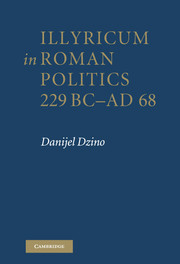Book contents
- Frontmatter
- Contents
- List of figures
- List of maps
- List of tables
- Acknowledgments
- Timeline
- 1 Introduction, approaches, review of sources and secondary literature
- 2 Illyricum in Roman foreign affairs: historical outline, theoretical approaches and geography
- 3 Roman trans-Adriatic engagement (229–168 BC)
- 4 Rome across the Adriatic in the late Republic (167–59 BC)
- 5 The construction of Illyricum: Caesar in Illyricum and the Civil Wars (59–44 BC)
- 6 Octavian in Illyricum
- 7 From senatorial to imperial Illyricum: Bellum Pannonicum
- 8 The failure of Greater Illyricum: the Bellum Batonianum
- 9 Iulio-Claudians in Illyricum: the tale of two provinces
- Conclusion: the construction of Illyricum in Roman political discourse
- Bibliography
- Index
9 - Iulio-Claudians in Illyricum: the tale of two provinces
Published online by Cambridge University Press: 05 May 2010
- Frontmatter
- Contents
- List of figures
- List of maps
- List of tables
- Acknowledgments
- Timeline
- 1 Introduction, approaches, review of sources and secondary literature
- 2 Illyricum in Roman foreign affairs: historical outline, theoretical approaches and geography
- 3 Roman trans-Adriatic engagement (229–168 BC)
- 4 Rome across the Adriatic in the late Republic (167–59 BC)
- 5 The construction of Illyricum: Caesar in Illyricum and the Civil Wars (59–44 BC)
- 6 Octavian in Illyricum
- 7 From senatorial to imperial Illyricum: Bellum Pannonicum
- 8 The failure of Greater Illyricum: the Bellum Batonianum
- 9 Iulio-Claudians in Illyricum: the tale of two provinces
- Conclusion: the construction of Illyricum in Roman political discourse
- Bibliography
- Index
Summary
In this period Illyricum became an essential part of the empire, its inhabitants were slowly but certainly on the way to ‘becoming Romans’, and there was no more need to treat this region as part of foreign affairs, except of course for the Danubian frontier. The administrative and political unity of ‘Greater’ Illyricum was broken into two parts, creating an entirely new geo-political situation, although a certain level of unity was maintained through the administration of the mining district metalla Illyrici (see below). The northern part, soon to become Pannonia, was formed as a frontier province for defence against a potentially hostile army threatening from beyond Pannonia. The Dalmatian coast was geographically and culturally already in many ways a part of the inner Mediterranean cultural core, strongly affected by the global processes and acculturation inside Roman imperial templates. The Dinaric Alps region, rich in mining resources, but much less exposed to global Mediterranean influences, stood between these two, but for administrative purposes was joined to the coastal region. The Bellum Batonianum exposed all the weaknesses of the Roman political conduct in ‘Greater’ Illyricum, and the Romans were compelled to make decisive changes if they wanted to maintain their position and avoid further troubles. The most important elements of the new Roman solutions for Illyricum were extensive road-building, resettlement of certain indigenous groups, removal of some indigenous youth through conscription into auxiliary units, military administration of the most dangerous civitates, immigration of foreigners into Illyricum, opening of economic links and additional military measures.
- Type
- Chapter
- Information
- Illyricum in Roman Politics, 229 BC–AD 68 , pp. 156 - 176Publisher: Cambridge University PressPrint publication year: 2010



